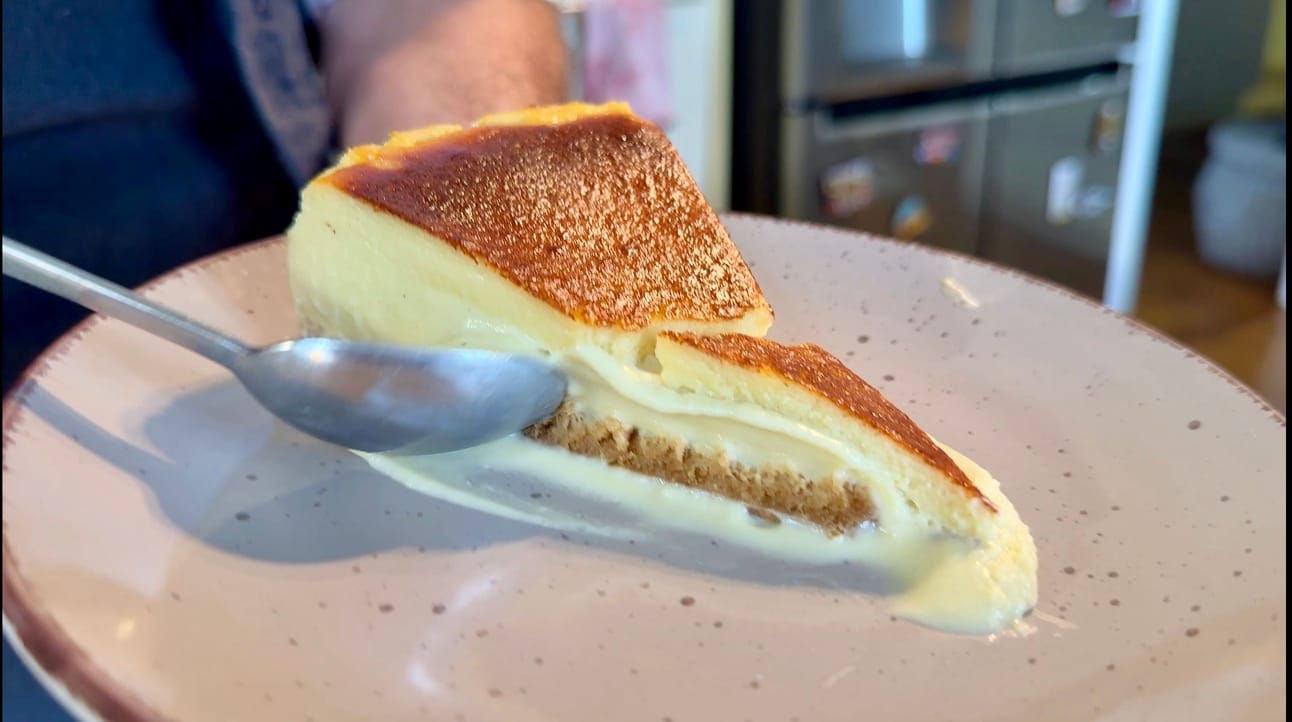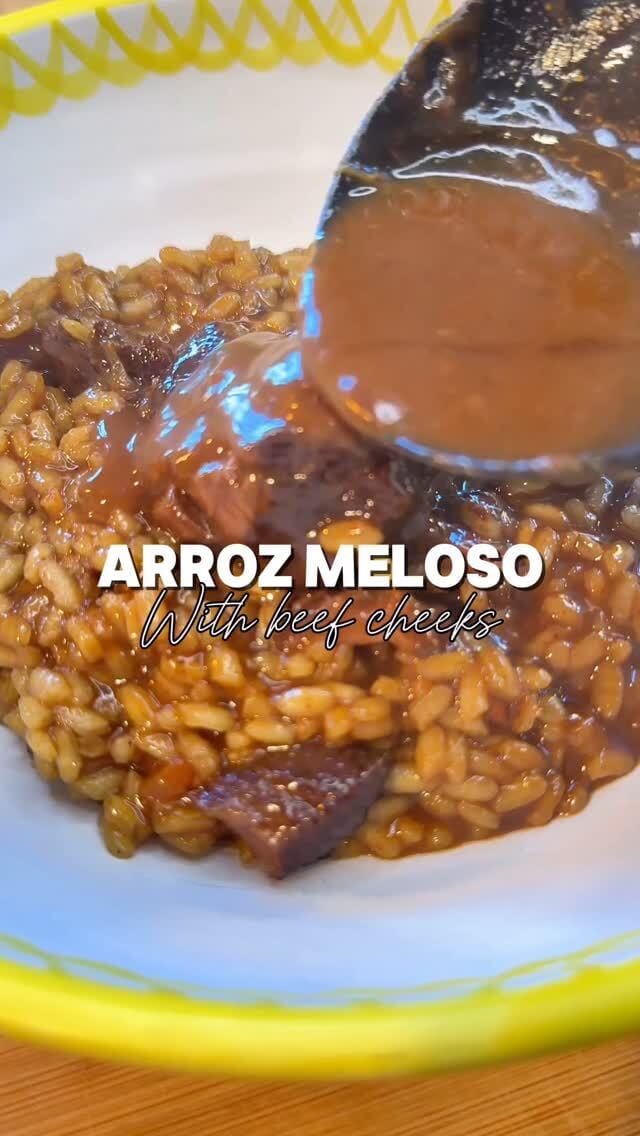- LA SOBREMESA
- Posts
- #7 The Burnt Basque Cheesecake... that isn't even that basque
#7 The Burnt Basque Cheesecake... that isn't even that basque
The Basque Country has better desserts, the rest of Spain has better cheesecakes... Let me explain.
Hi team!
Hope you're having a beautiful start to June. Summer is slowly creeping into our daily routines—cozy cafés are turning into sunny terraces, and woodland walks are becoming swims in the ocean (for those lucky enough to live by the sea).
Last week, my partner in crime and I took a big step: we packed up her Volkswagen Beetle and drove all the way from Vienna to Vigo, my hometown. Over 2,000 km and a stunning route through the north of Spain, including a strategic stop in one of my favorite gastronomic cities in the world: Donostia–San Sebastián. We even did a Pintxos Route you don’t want to miss. You can check the full video here:
That stop in the Basque Country, apart from filling our hearts (and stomachs), inspired me to write today’s article: the world-famous Basque Burnt Cheesecake.
f you're curious about the recipe, check last week’s recipe of the week or head over to my YouTube vid for a full, step-by-step breakdown. But this article isn’t about the recipe itself—it’s about how a random trend can create a massive influence in today’s food world.

Before this cheesecake, there were actual Basque desserts
Nope. The burnt cheesecake is not the most traditional or famous dessert in the Basque Country.
If you ask someone from Euskadi about their favourite sweet treats… the chances of them saying "tarta de queso" are not that high. The Basque Country has a rich pastry tradition that goes way beyond cheesecake. Here’s a bunch of them for you to look up:
Pantxineta: Puff pastry filled with custard and topped with sliced almonds.
Pastel Vasco: A filled cake with two regional versions—on the French side, it’s filled with cherry jam; on the Spanish side, with custard.
Tejas y cigarrillos de Tolosa: Thin, crispy almond cookies with playful shapes. Your best friend to enjoy with coffee after a rich lunch or dinner.
Goxua: A layered dessert of whipped cream, sponge cake soaked in syrup, custard, and caramel. Goxua literally means “yummy” in Basque.
Intxaursalsa: A creamy walnut-based dessert soup traditionally eaten at Christmas.
That said… let’s talk about Burnt Basque Cheesecake, because while it may not be the most traditional, it’s certainly one of the most iconic modern Basque desserts—and I mean modern. This creamy, caramelised cheesecake with its signature scorched top comes from a humble pintxo bar in San Sebastián: La Viña. And it wasn’t until the late 2000s or even 2010s that the recipe truly exploded into a global trend.
They were not the first one making it, neither the best in the city —try the one of La Consentida, in the neighbourhood of Gros—, but they did serve a decent quality, and had the perfect location to get the attention of the almost one million tourist that visit San Sebastian per year.
But here’s the thing: even though it became famous under the name “Basque Cheesecake”, what we’re really talking about is a very Spanish style of baked cheesecake—present in pretty much every region. The recipe is always more or less the same: a creamy cheese base, eggs, sugar, cream, and into the oven. What changes is the cheese used to give it personality. Many chefs (and home bakers) like to mix in a more intense local cheese—blue, goat, smoked, or even Manchego—to add depth and a regional twist.
One of the most curious parts is how the doneness of the cake has become a trend in itself. That creamy, spoonable center we —me 😂— now associate with the perfect cheesecake wasn’t always the trend. Just like with tortilla de patatas, preferences vary depending on where you are. And let’s be honest, in places where summer means 32°C in the shade, a runny-inside cheesecake was probably never the go-to option due to sanitary reasons.
Personally, I’m a huge fan of this dessert. Whenever I see tarta de queso on the menu, I feel the urge to try it. Although… never before asking the waiter: “La tarta de queso… es al horno, verdad?” Just to make sure we’re talking about the Spanish style—always baked and slightly toasted on top. Nothing against the NY style cheesecake, but that’s just a completely different thing.
So next time you’re in Spain and see tarta de queso on the menu—order it. Seriously. You’ll find that every place has its own take: more toasted, more liquid, more funky cheese, or just plain simple. That’s the beauty of it. Same idea, infinite variations
PINTXO TOUR in San Sebastian
Two-three bites. Homemade. Innovative. With personality. Freshly made. Quality products. Skilled service. Clear info. Donostia style. Local roots.
Those are the ten rules defined by the Instituto del Pintxo de Donostia to preserve the essence of a tradition that, along with other iconic staples, makes Basque gastronomy one of the most important in Spain — and probably in the world.
Check out my new video for some of my favourite spots in the city, plus a little reflection on where this culture stands today (Spoiler: the old town seems confused).
If you don’t have time to watch it now… How about you just click on this bottom to directly subscribe to my channel? 😎
RECIPE OF THE WEEK
Arroz meloso con carrilleras (two recipes in one)
This recipe was the result of a collaborative reel with Magefesa, a spanish brand that produce quality kitchenware for home cooks, and specialised in pressure cookers. Basically, if you are spanish and ask your grandparents about pressure pots… they will tell you only to trust high quality brands like Magefesa (with pressure cooking… getting the cheap version may cost you more than money).
Anyway… they asked me to use one of their pressure cookers for a recipe, to promote their products in the US. And let me be honest: I had never used a pressure pot before in my entire life. Some of the reasons are that I never really had one, together with that I actually enjoy the three, four, or six hours that some tough cuts need of cooking time. To me, those hours of a sligh bubble bouncing through my stew, at minimun heat, while my whole apartmen smells like heaven is… I don’t know… Like a cheap but effective therapy of meditation.
But I get it. Not everybody enjoy and/or have the time to do so. That’s why this tool was revolucionary for home —and proffesional— kitchens. Because you may not have the time, but you deserve, and have the right, to enjoy a rich, flavourful and mellow beef cheek stew at home every now and then.
RECIPE 1: Beef cheeks stew (serves around 6 portions)
1 kg beef cheeks
300 g onion
130 g carrot
120 g celery
150 g leek
38 g garlic
35 g tomato paste
500 g good red wine
Beef/chicken stock to cover (I used 500 g)
1 sprig thyme
1 sprig rosemary
2 bay leaves
Salt and pepper to taste
4 tbsp olive oil
🔥 Method:
Clean your beef cheeks, removing connective tissue and excess fat (or ask your butcher to do it). Chop all the vegetables, and tie the aromatics together with kitchen twine to make a bouquet garni — this will help you remove them later to avoid overpowering the stew.
Preheat the pressure cooker with the olive oil over medium-high heat. Season the beef cheeks with salt and pepper on both sides. Sear them in the pot for 5 minutes per side. You want a deep golden-brown crust and a nice fond stuck to the bottom — essential for flavour. Set the meat aside.
Add the chopped vegetables to the pot and stir-fry over medium-high heat. Their moisture will help deglaze the fond. After about 10 minutes, when the veggies are soft and slightly caramelised, add the tomato paste, the bouquet garni, and the wine. Cook for another 10 minutes to reduce the wine and concentrate the flavour.
Once reduced, return the meat to the pot, cover with stock, and season with salt. Close the pressure cooker and bring it to high heat until it starts releasing steam. Once it does, lower the heat and cook for 40 minutes.
— if you don’t have or want to use a pressure cooker, just cover and cook at low heat for 4 to 5 hours—
After 40 minutes, remove the meat and strain the stock. Reserve one-third of the liquid and thicken it with a teaspoon of cornstarch diluted in cold water. Return the meat to the pot and stew for another 20 minutes to get the perfect texture.
The rest of the stock is the perfect ally to make next recipe:
RECIPE 2: Meloso rice with beef cheeks stew (serves 3-4 portions)
200 g of round rice (like bomba or risotto rice)
4 stewed cheeks and a couple of tbsp of the sauce (from the last recipe)
1 kg of the beef cheek stock
2 tbsp olive oil
1 pinch saffron
🔥 Method:
Grind the saffron and infuse it in a cup of cold water.
In a low pot, heat the olive oil over medium-high and toast the rice for about 5 minutes.
Start adding the hot beef cheek stock little by little, stirring constantly. Keep adding more stock as the rice absorbs it. Add the saffron infusion after 10 minutes.
Depending on the rice variety, you’ll need around 800–1000 g of stock. Follow the cooking time indicated on the package.
In the final 5 minutes, add the cheeks and a bit of the sauce.


Reply